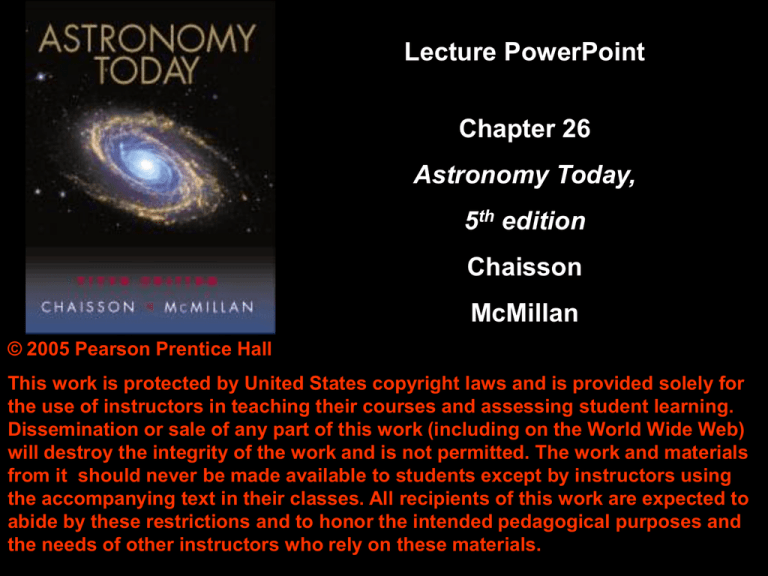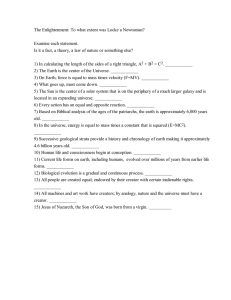
Lecture PowerPoint
Chapter 26
Astronomy Today,
5th edition
Chaisson
McMillan
© 2005 Pearson Prentice Hall
This work is protected by United States copyright laws and is provided solely for
the use of instructors in teaching their courses and assessing student learning.
Dissemination or sale of any part of this work (including on the World Wide Web)
will destroy the integrity of the work and is not permitted. The work and materials
from it should never be made available to students except by instructors using
the accompanying text in their classes. All recipients of this work are expected to
abide by these restrictions and to honor the intended pedagogical purposes and
the needs of other instructors who rely on these materials.
Chapter 26
Cosmology
Units of Chapter 26
The Universe on the Largest Scales
The Expanding Universe
Stunning Views of Deep Space
The Fate of the Cosmos
The Geometry of Space
Curved Space
Will the Universe Expand Forever?
Einstein and the Cosmological Constant
Units of Chapter 26
Dark Energy and Cosmology
The Cosmic Microwave Background
26.1 The Universe on the Largest Scales
This galaxy map shows the largest structure
known in the universe, the Sloan Great Wall.
No structure larger than 300 Mpc is seen.
26.1 The Universe on the Largest Scales
This pencil-beam survey is another measure of
large-scale structure. Again, there is structure at
about 200–300 Mpc, but nothing larger.
26.1 The Universe on the Largest Scales
Therefore, the universe is homogenous (any
300-Mpc-square block appears much like any
other) on scales greater than about 300 Mpc.
The universe also appears to be isotropic – the
same in all directions.
The cosmological principle includes the
assumptions of isotropy and homogeneity.
26.2 The Expanding Universe
Olbers’s Paradox:
If the universe is
homogeneous,
isotropic, infinite, and
unchanging, the
entire sky should be
as bright as the
surface of the Sun.
26.2 The Expanding Universe
So, why is it dark at night?
The universe is homogeneous and isotropic –
It must not be infinite and/or unchanging.
We have already found that galaxies are
moving faster away from us the farther away
they are:
26.2 The Expanding Universe
So, how long did it take the galaxies to get
there?
26.2 The Expanding Universe
Using
we find that time is about 14 billion years.
Note that Hubble’s law is the same no matter
who is making the measurements.
26.2 The Expanding Universe
If this expansion is extrapolated backwards in
time, all galaxies are seen to originate from a
single point in an event called the Big Bang.
So, where was the Big Bang?
It was everywhere!
No matter where we are in the universe, we
will measure the same relation between
recessional velocity and distance, with the
same Hubble constant.
26.2 The Expanding Universe
This can be demonstrated in two dimensions.
Imagine a balloon with coins stuck to it. As
we blow up the balloon, the coins all move
farther and farther apart. There is, on the
surface of the balloon, no “center” of
expansion.
26.2 The Expanding Universe
The same analogy can be used to explain the
cosmological redshift:
26.2 The Expanding Universe
These concepts are hard to comprehend, and
not at all intuitive. A full description requires
the very high-level mathematics of general
relativity.
However, there are aspects that can be
understood using relatively simple Newtonian
physics – we just need the full theory to tell
us which ones!
26.3 The Fate of the Cosmos
There are two possibilities for the universe in
the far future:
1. It could keep expanding forever.
2. It could collapse.
Assuming that the only relevant force is
gravity, which way the universe goes
depends on its density.
26.3 The Fate of the Cosmos
If the density is low, the universe will expand
forever.
If it is high, the
universe will
ultimately collapse.
26.3 The Fate of the Cosmos
There is a critical density between collapse and
expansion. At this density the universe still
expands forever, but the expansion speed goes
asymptotically to zero as time goes on.
Given the present value of the Hubble constant,
that critical density is:
This is about five hydrogen atoms per cubic
meter.
26.4 The Geometry of Space
If space is homogeneous, there are three
possibilities for its overall structure:
1. Closed – this is the geometry that leads to
ultimate collapse
2. Flat – this corresponds to the critical density
3. Open – expands forever
26.4 The Geometry of Space
These three
possibilities are
illustrated here. The
closed geometry is
like the surface of a
sphere; the flat one is
flat; and the open
geometry is like a
saddle.
26.4 The Geometry of Space
These three possibilities also can be described
by comparing the actual density of the universe
to the critical density.
Astronomers refer to the actual density of the
universe as Ω, and to the critical density as Ω0.
Then we can describe the three possibilities as:
Ω < Ω0
Open geometry
Ω = Ω0
Flat geometry
Ω > Ω0
Closed geometry
26.4 The Geometry of Space
In a closed universe,
you can travel in a
straight line and end
up back where you
started.
26.5 Will the Universe Expand Forever?
The answer to this question lies in the actual
density of the universe.
Measurements of luminous matter suggest that
the actual density is only a few percent of the
critical density.
But – we know there must be large amounts of
dark matter.
26.5 Will the Universe Expand Forever?
However, the best estimates for the
amount of dark matter needed to bind
galaxies in clusters, and to explain
gravitational lensing, still only bring the
observed density up to about 0.3 times the
critical density, and it seems very unlikely
that there could be enough dark matter to
make the density critical.
26.5 Will the Universe Expand Forever?
Type I supernovae can be used to measure
the behavior of distant galaxies.
If the expansion of the universe is
decelerating, as it would if gravity were the
only force acting, the farthest galaxies had a
more rapid recessional speed in the past, and
will appear as though they were receding
faster than Hubble’s law would predict.
26.5 Will the Universe Expand Forever?
However, when we look at
the data, we see that it
corresponds not to a
decelerating universe, but to
an accelerating one.
This acceleration cannot be
explained by current
theories of the universe,
although we do know it is
not caused by either matter
or radiation.
26.5 Will the Universe Expand Forever?
Possible explanation for the acceleration:
vacuum pressure (cosmological constant),
also called dark energy
26.6 Dark Energy and Cosmology
What else supports the “dark energy”
theory?
• In the very early life of the universe, the
geometry must be flat
• The assumption of a constant expansion
rate predicts the universe to be younger
than we observe
26.6 Dark Energy and Cosmology
This graph now includes the accelerating
Given what we now know, the age
universe.
of the
universe
works out to
be 13.7
billion years.
26.6 Dark Energy and Cosmology
This is consistent with other observations,
particularly of the age of globular clusters, and
yields the following timeline:
14 billion years ago: Big Bang
13 billion years ago: Quasars form
10 billion years ago: First stars in our Galaxy form
26.7 The Cosmic Microwave Background
The cosmic microwave background was
discovered fortuitously in 1964, as two
researchers tried to get rid of the last bit of
“noise” in their radio antenna.
Instead they found that
the “noise” came from all
directions and at all
times, and was always the
same. They were
detecting photons left
over from the Big Bang.
26.7 The Cosmic Microwave Background
When these photons were created, it was only one
second after the Big Bang, and they were very
highly energetic. The expansion of the universe
has redshifted
their wavelengths
so that now they
are in the radio
spectrum, with a
blackbody curve
corresponding to
about 3 K.
26.7 The Cosmic Microwave Background
Since then, the cosmic background spectrum
has been measured with great accuracy.
26.7 The Cosmic Microwave Background
A map of the microwave sky shows a distinct
pattern, due not to any property of the radiation
itself, but to Earth’s motion:
Summary of Chapter 26
• On scales larger than a few hundred
megaparsecs, the universe is homogeneous and
isotropic
• The universe began about 14 million years ago,
in a Big Bang
• Future of the universe: either expand forever, or
collapse
• Density between expansion and collapse is
critical density
Summary of Chapter 26, cont.
• A high-density universe has a closed
geometry; a critical universe is flat; and a lowdensity universe is open
• Luminous mass and dark matter comprise at
most 30% of the critical density
• Acceleration of the universe appears to be
speeding up, due to some form of dark energy
• The universe is about 14 billion years old
• Cosmic microwave background is photons left
over from Big Bang



